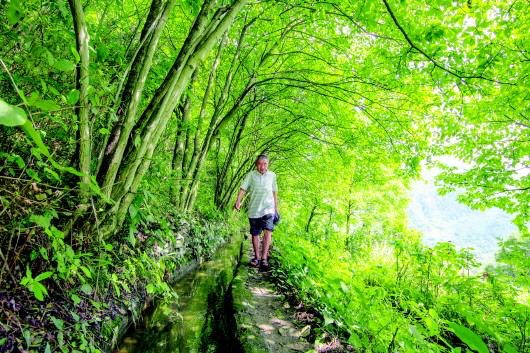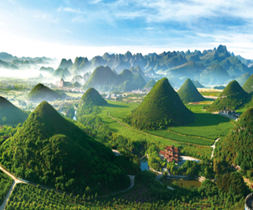Home>Updates
The dream that took 36 years to fulfill
Updated: 2017-01-20

Huang Dafa walks along Dafa Canal to make sure everything is going well. [Photo/zaqxn.com]
Hidden deep in the mountains in northern Guizhou flows Dafa canal, which brings water and hope to the residents of Caoyuanba team, a jurisdiction of Tuanjie village.
The construction of the canal spanned for 36 years and was completed in 1995 under the guidance of Huang Dafa, a former official of Caoyuanba.
Life before 1995 was very hard for Caoyuanba villagers. Due to lack of water, they could only plant corn and potatoes to live on, and rice was a luxury only available during Spring Festival. At that time, the village had no electricity and no decent roads, earning it the name of the “poorest part” of the surrounding area.
Drawing water to Caoyuanba had been a long-cherished dream for the local people. Things started to change in 1959 when Huang Dafa was selected as a leader for the team. Huang was an orphan born into the team in 1936 and his neighbors brought him up.
“I decided to do three things for the villagers: draw water to the village, build a road and get access to electricity,” Huang said when recalling his early days.
Huang found that Yebiao village, a few kilometers away, had water to spare. If Huang could find a way to bring the water through Lingbao Mountain, which lies between the two villages, Caoyuanba would solve its water supply problem.
However, things did not go well at the beginning. Knowing very little about water conservancy, Huang could not build a workable canal, and after more than 10 years water was still a remote dream for the people of Caoyuanba.
Although some people said that Caoyuanba would never get access to water, Huang never lost hope. At the age of 53, when he was transferred to work at the water management station in Fengxiang district, he started to study water technology
After three years, Huang had accumulated a vast amount of knowledge about canal digging and was determined to achieve his dream. With his professional knowledge and persistence, he received support from local governments which allocated 60,000 yuan ($8,728) and 380,000 kilograms of corn to Caoyuanba.
The villagers also donated 10,000 yuan to help pay for the digging of the canal. From 1992, Huang led 200 people in digging the canal. Their efforts paid off in 1995 when water rushed to Caoyuanba through a 7,200-meter main canal and 2,200 meters of branch canals.
With enough water, people started to change their non-irrigated farmland to grow rice. Huang then helped the locals increase the village’s rice-growing land to 48 hectares.
In the same year, the village was connected to electricity and a new road was built. All three projects were led by Huang. He also encouraged locals to develop some education and helped to build two schools in the 1960s and then in the 1990s.
As the days passed, the villagers increased their income thanks to the improved land and living conditions. However, now in his eighties Huang still thinks about how to improve the lives of the villagers and maintains the habit of checking the canals regularly to make sure the system is working well.
Edited by Mark Ray
